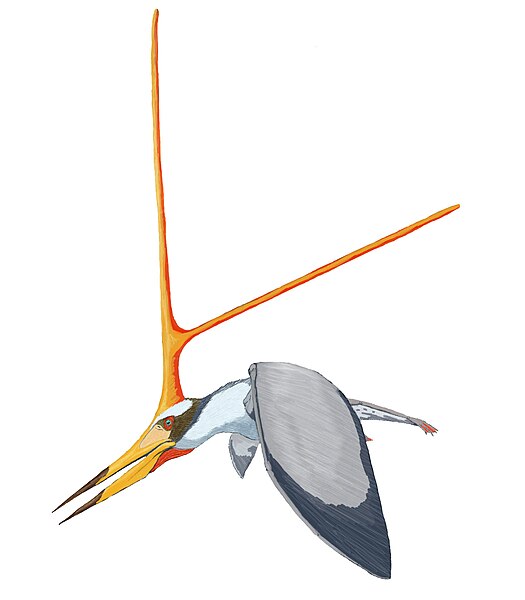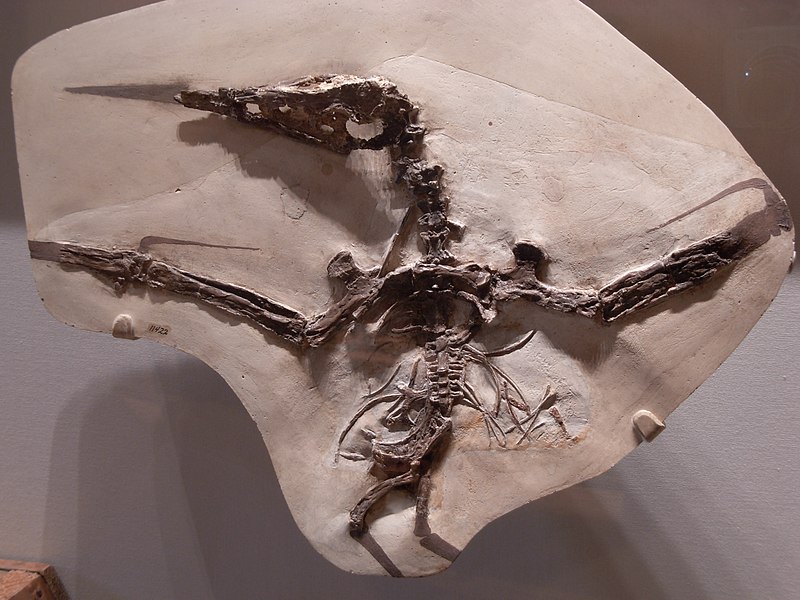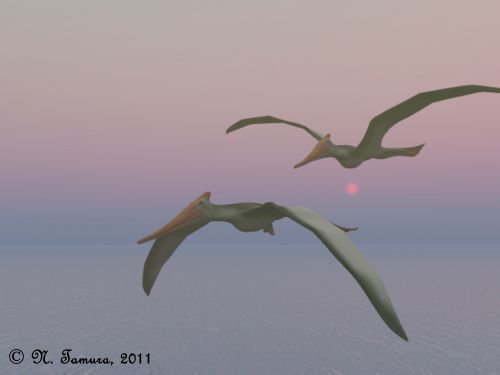[Recent Entries][Archive][Friends][User Info]
Below are the 2 most recent journal entries recorded in the "Сообщество, посвящённое ра" journal:| October 9th, 2014 | |
|---|---|
| 12:01 pm [industrialterro] [Link] |
Muzquizopteryx Muzquizopteryx is a genus of pterodactyloid pterosaur (flying reptile) from the Late Cretaceous of what is now Coahuila,Mexico. In the nineties José Martínez Vásquez, a worker at the chalk quarry of El Rosario, uncovered a skeleton of a pterosaur. This he handed to a quarry official, who had it bricked in on the face of an office wall as a decorative piece. After its unique scientific value had been recognised in 2002, the specimen was acquired by the Universidad Nacional Autónoma de México. Subsequently it was studied by a combined team of the University of Karlsruhe and the University of Heidelberg, in this financially supported by the Volkswagen company. The specimen was scientifically reported in 2004. In 2006 the type species Muzquizopteryx coahuilensis was named and described by Eberhard Frey, Marie-Céline Buchy,Wolfgang Stinnesbeck, Arturo González-González and Alfredo di Stefano. The generic name is derived from the Múzquizdistrict and a Greek πτέρυξ, pteryx, "wing". The specific name is derived from the state of Coahuila. Muzquizopteryx is based on holotype UNAM IGM 8621, found in the El Rosario layers, early Coniacian-aged rocks. It consists of a nearly complete, articulated skeleton that includes soft tissue remains, among them long fossilised tendons along both sides of both lower arms. The specimen represents an adult individual. In 2012 a second specimen was reported, MUDE CPC-494, again uncovered by a quarry worker, perhaps at the same site, and sold to a private collector. It was later acquired by the Museo del Desierto Saltillo. It consists of the right upper wing of a subadult individual, with about 81% of the length of the holotype. As its provenance probably consists of slightly older layers from the late Turonian and the remains are limited, it was referred to a Muzquizopteryx sp. Muzquizopteryx was relatively small for a pterodactyloid pterosaur, with a wingspan of around two metres (6.6 ft). It had an elongated head with a convex upper profile, ending at the back of the head in a backward pointing short rounded crest. The jaws were toothless. The arms were very robust with the humerus featuring a large hatchet-shaped deltopectoral crest, indicating a strong wing musculature. The pteroid bone was long and pointed towards the neck, supporting a flight membrane. Muzquizopteryx was by its describers assigned to the Nyctosauridae. It would then be the oldest known member of the group and the smallest known; indeed the smallest adult Late Cretaceous pterosaur discovered until 2006. As Nyctosaurus is sometimes included with the Pteranodontidae, Muzquizopteryx too might be considered a member of that group under some classifications. Tags: Вымершие рептилии, Мел, авеметатарзалии, архозавроморфы, архозавры, диапсиды, монофенестраты, никтозавриды, орнитохейройды, птеродактили, птерозавры |
| October 8th, 2014 | |
| 02:31 pm [industrialterro] [Link] |
Nyctosaurus Nyctosaurus is a genus of pterodactyloid pterosaur, the remains of which have been found in the Niobrara Formation of the mid-western United States, which, during the late Cretaceous Period, was covered in an extensive shallow sea. The genus Nyctosaurus has had numerous species referred to it, though how many of these may actually be valid requires further study. At least one species possessed an extraordinarily large antler-like cranial crest. Nyctosaurus was similar in anatomy to its close relative and contemporary, Pteranodon. It had relatively long wings, similar in shape to modern seabirds. However, it was smaller overall than Pteranodon, with an adult wingspan of 2 meters (6.6 ft) and a maximum weight of about 1.86 kg. The overall body length was 37 cm. Some specimens preserve a distinctive crest, at least 55 cm tall in old adults, relatively gigantic compared to the rest of the body and over three times the length of the head. The crest is composed of two long, grooved spars, one pointed upward and the other backward, arising from a common base projecting up and back from the back of the skull. The two spars were nearly equal in length, and both were nearly as long or longer than the total length of the body. The upward-pointing crest spar was at least 42 cm long (1.3 ft) and the backward-pointing spar was at least 32 cm long (1 ft). The jaws of Nyctosaurus were long and extremely pointed. The jaw tips were thin and needle sharp, and are often broken off in fossil specimens, giving the appearance that one jaw is longer than the other, though in life they were probably equal in length. Nyctosaurus is the only pterosaur to have lost its clawed "fingers", with the exception of the wing finger (of which however the fourth phalanx was lost), which is likely to have impaired its movement on the ground, leading scientists to conjecture that it spent almost all of its time on the wing and rarely landed. In particular, the lack of claws with which to grip surfaces would have made climbing or clinging to cliffs and tree trunks impossible for Nyctosaurus. Nyctosaurus, like its relative Pteranodon, appears to have grown very rapidly after hatching. Fully adult specimens are no larger than some immature specimens such as P 25026, indicating that Nyctosaurus went from hatching to adult size (with wingspans of 2 m or more) in under a year. Some sub-adult specimens have been preserved with their skulls in nearly pristine condition, and lack any trace of a head crest, indicating that the distinctively large crest only began to develop after the first year of life. The crest may have continued to grow more elaborate as the animal aged, though no studies have examined the age of the fully adult, large-crested specimens. These individuals may have been 5 or even 10 years old at the time of their deaths. Only five relatively complete Nyctosaurus skulls have been found. Of those, one is juvenile and does not possess a crest (specimen FMNH P 25026), and two are more mature and may show signs of having had a crest but are too badly crushed to say for sure (FHSM 2148 and CM 11422). Two specimens (KJ1 and KJ2) described in 2003, however, preserved an enormous double-pronged crest. A few scientists had initially hypothesized that this crest, which resembles an enormous antler, may have supported a skin "headsail" used for stability in flight. While there is no fossil evidence for such a sail, studies have shown that a membranous attachment to the bony crest would have imparted aerodynamic advantages. However, in the actual description of the fossils, paleontologist Christopher Bennett argued against the possibility of a membrane or soft tissue extension to the crest. Bennett noted that the edges of each prong were smooth and rounded, and showed no evidence for any soft-tissue attachment points. He also compared Nyctosaurus with large-crested tapejarids, which do preserve soft tissue extensions supported by prongs, and showed that in those species, the attachment points were obvious, with jagged edges where the transition from bone to soft tissue occurred. Bennett concluded that the crest was most likely used solely for display, citing similar structures in modern animals. The 2009 study by Xing and colleagues testing the aerodynamics of the giant crest with a "headsail" also tested the aerodynamics of the same crest with no sail, and found that it added no significant negative factors, so a crest with no headsail would not have hindered normal flight. It is more likely that the crest acted mainly for display, and that any aerodynamic effects it may have had were secondary. Bennett also argued that the crest was probably not a sexually dimorphic character, as in most crested pterosaurs, including the related Pteranodon, both sexes are crested and it is only the size and shape of the crest that differs. The apparently non-crested Nyctosaurus specimens therefore probably came from sub-adults. Sankar Chatterjee and R.J. Templin used estimates based on complete Nyctosaurus specimens to determine weight and total wing area, and to calculate its total wing loading. They also estimated its total available flight power based on estimated musculature. Using these calculations, they estimated the cruising speed of Nyctosaurus gracilis as 9.6 meters/second (34.5 kilometers/hour or 21.4 miles/hour). All known Nyctosaurus fossils come from the Smokey Hills Chalk of Kansas, part of the Niobrara Formation. Specifically, they are found only within a narrow zone characterised by the abundance of ammonite fossils belonging to the species Spinaptychus sternbergi. These limestone deposits were laid down during a marine regression of the Western Interior Seaway that lasted between 85 and 84.5 million years ago. Therefore, Nyctosaurus was a relatively short-lived species, unlike its relative Pteranodon, which is found throughout almost all of the Niobrara layers into the overlying Pierre Shale Formation, and existed between 88 and 80.5 million years ago. The ecosystem preserved in this zone was unique in its abundance of vertebrate life. Nyctosaurus shared the sky with the bird Ichthyornis and with Pteranodon longiceps, though the second Niobrara Pteranodon species, P. sternbergi, had disappeared from the fossil record by this point. In the waters of the Western Interior Seaway below swam mosasaurs (Clidastes, Ectenosaurus and Tylosaurus), the flightless diving bird Parahesperornis, and a wide variety of fish, including swordfish-like Protosphyraena, the predatory Xiphactinus and the shark Cretolamna. The first Nyctosaurus fossils were described in 1876 by Othniel Charles Marsh, based on fragmentary material, holotype YPM 1178, from the Smoky Hill River site in Kansas. Marsh referred the specimen to a species of his new genus Pteranodon, as Pteranodon gracilis. Later that year, Marsh reclassified the species in its own genus, which he named Nyctosaurus, meaning "night lizard" or "bat lizard", in reference to the wing structure somewhat paralleling those of bats. In 1881, Marsh incorrectly assumed the name was preoccupied and changed it into Nyctodactylus, which thus is now a junior synonym. In 1902,Samuel Wendell Williston described the most complete skeleton then known (P 25026) discovered in 1901 by H. T. Martin. In 1903, Williston named a second species, N. leptodactylus, but this is today considered identical to N. gracilis. In 1953, Llewellyn Ivor Price named a partial humerus, DGM 238-R found in Brazil, N. lamegoi; the specific name honours the geologist Alberto Ribeiro Lamego. This species has an estimated wingspan of four metres; it is today generally considered to be a form different from Nyctosaurus, but has not yet been assigned its own genus name. In 1972 a new skeleton, FHSM VP-2148, in 1962 discovered by George Fryer Sternberg, was named N. bonneri; it is today generally seen as identical to N. gracilis. In 1978 Gregory Brown prepared the most complete Nyctosaurus skeleton currently known, UNSM 93000. In 1984 Robert Milton Schoch renamed Pteranodon nanus (Marsh 1881), "the dwarf", Nyctosaurus nanus. The question of this species validity is currently pending further study. In the early 2000s, Kenneth Jenkins of Ellis, Kansas collected two specimens of Nyctosaurus which were the first to demonstrate conclusively that not only was this species crested, the crest in mature specimens was very large and elaborate. The specimens were purchased by a private collector in Austin, Texas. Despite being in private hands rather than a museum collection, paleontologist Chris Bennett was able to study the specimens and gave them the manuscript reference numbers KJ1 and KJ2 (for Kenneth Jenkins). Bennett published a description of the specimens in 2003. Despite the unusual crests, the specimens were otherwise indistinguishable from other specimens of Nyctosaurus. However, the then-currently named species were extremely similar and Bennett declined to refer them to a specific one pending further study of the differences, or lack therof, between species of Nyctosaurus. ( Read More )       ( Read More )       Tags: Вымершие рептилии, Мел, авеметатарзалии, архозавроморфы, архозавры, диапсиды, монофенестраты, никтозавриды, орнитохейройды, птеродактили, птерозавры |



